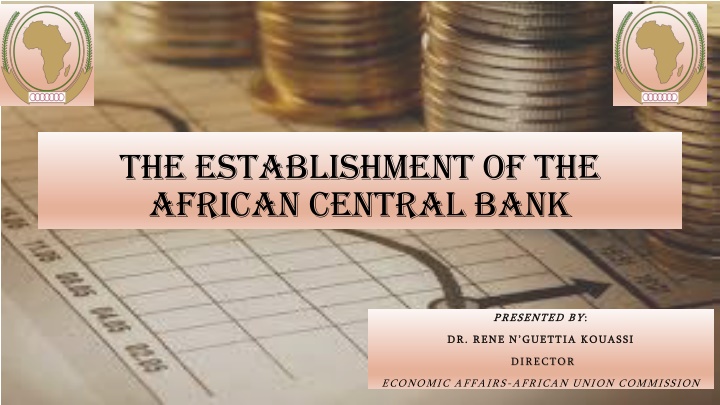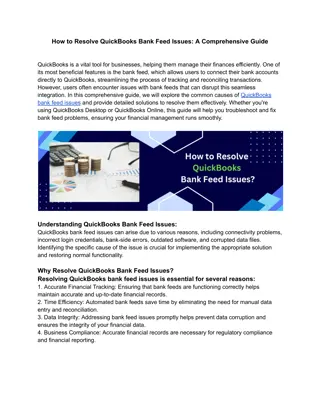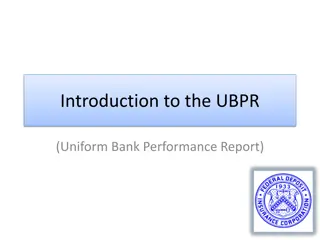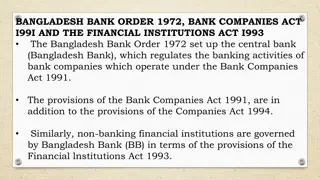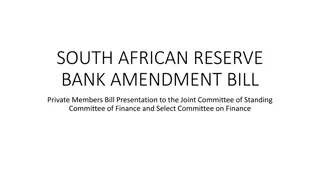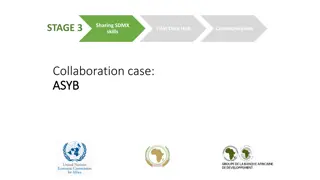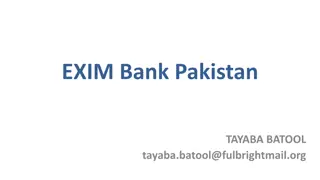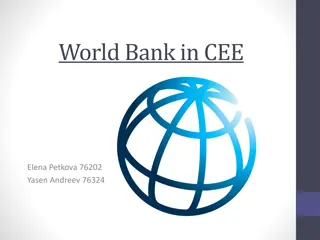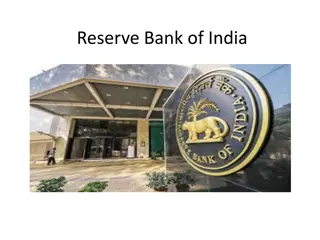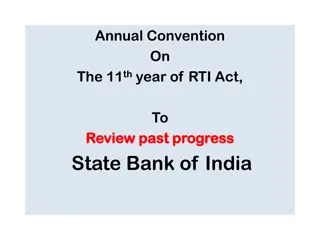Establishment of African Central Bank: Background and Strategy
The African Central Bank (ACB) has a rich history dating back to the Abuja Treaty in 1991, with a vision for a single African Currency. Over the years, key milestones have been achieved, such as the signing of MoU with the Nigerian Government in 2009 and the validation of the AUC-AACB Joint Strategy Report in 2013. The strategy focuses on the political economy context, objectives of the African Union, legal frameworks, and integration stages to pave the way for the African Monetary Union and a single currency. Learn about the ongoing efforts towards economic and monetary integration in Africa.
Download Presentation

Please find below an Image/Link to download the presentation.
The content on the website is provided AS IS for your information and personal use only. It may not be sold, licensed, or shared on other websites without obtaining consent from the author.If you encounter any issues during the download, it is possible that the publisher has removed the file from their server.
You are allowed to download the files provided on this website for personal or commercial use, subject to the condition that they are used lawfully. All files are the property of their respective owners.
The content on the website is provided AS IS for your information and personal use only. It may not be sold, licensed, or shared on other websites without obtaining consent from the author.
E N D
Presentation Transcript
the establishment of the African Central Bank PRESENTED BY PRESENTED BY: : DR. DR. RENE N GUETTIA RENE N GUETTIA KOUASSI KOUASSI DIRECTOR ECONOMIC AFFAIRS-AFRICAN UNION COMMISSION
OUTLINE I. BACKGROUND I. BACKGROUND TO THE ESTABLISHMENT OF THE AFRICAN CENTRAL TO THE ESTABLISHMENT OF THE AFRICAN CENTRAL BANK (ACB) BANK (ACB) II. THE AUC THE AUC- -AACB JOINT STRATEGY AACB JOINT STRATEGY
Background to the Establishment of the African Central Bank (ACB) 1991 : The Abuja Treaty (Art. 5) : The establishment of a single African Central Bank and the creation of a single African Currency 2000: The Constitutive Act of the African Union (Art. 19): The Union shall have the following financial institutions The African Central Bank 2005: AU Assembly Decision on location of AU Institutes (Assembly/AU/Dec.64): African Central Bank - Western Region designated to Nigeria.
Background to the Establishment of the African Central Bank (ACB) 2009: AU Commission signs MoU with the Nigerian Government to host the ACB. 2013: AUC-AACB Joint Strategy Report on the Establishment of the ACB is validated by AUC-AACB Joint Committee 2015: AUC-AACB Joint Strategy Report is adopted by the AACB Assembly of Governors.
The AUC-AACB Joint Strategy ( Takes into account Political Economy Context, Objectives of the African Union, various African Union legal frameworks and attendant initiatives, and the different stages of integration attained by the Regional Economic Communities. Discusses stages and approaches; preconditions for successful economic and monetary union, and the net benefits of economic and monetary union; it also highlights lessons learned from the Euro zone debt crisis and monetary unions worldwide. Provides strategies and a roadmap with clear tasks and timelines leading to the establishment of the African Monetary Union, African Single Currency, while highlighting the role of the African Monetary Institute (AMI). The African Central Bank and the
The AUC-AACB Joint Strategy ( ) Mar Creation of theAfrican Monetary Institution (AMI). 2015 Effective FTAs at REC levels and preparations for effective Customs Unions; Strengthening Macroeconomic convergence and Financial Integration; Tripartite Free Trade Area (TFTA), PIDA (phase I-II), and resolution of overlapping REC membership. 2018 Effective RECs Customs Union Deepening of Macroeconomic Convergence and Financial Integration PIDA (phase II continued) and establishment of Continental Free TradeArea (CFTA) Mar Dec, Dec, 2014 2014: 2015 2017 2017: 2018 2022 2022:
The AUC-AACB Joint Strategy ( ) 2023 Effective REC Common Markets and establishment of REC Central Banks and Fiscal Banking Unions by 2028. Further strengthening of macroeconomic convergence and financial integration (payments and settlement systems, sub-regional and regional stock exchanges,). PIDA (phase III) and establishment of Continental Customs Union. 2023 - - 2028: 2028: 2029 Establishment of an African Common Market and Economic and Monetary Union, including Continental Fiscal and Banking Unions culminating in the African Central Bank and Single Currency. 2029 2034: 2034:
The AUC-AACB Joint Strategy Political Commitment: Creation of Ministries of Integration and REC Affairs in all African Countries. Governance and Implementation Strategy: AU Conference of African Ministers of Economy and Finance (STC on Finance, Monetary Affairs, Economic Planning and Integration) to monitor the process. The African Monetary Institute (AMI) should be set up to undertake the preparatory work and then report through Joint Committee to the STC, the Council of Ministers and Heads of State and Government. Voluntary Memberships to allow countries to join when they are ready to meet criteria. Overlapping memberships in RECs needs to be resolved so countries identify with an individual REC as their vehicle for monetary integration.
The AUC-AACB Joint Strategy Integration stages and approach that focuses on eliminating obstacles and creating convergence at REC level before aiming at continental level; harmonize the AACB African Monetary Cooperation Programme (AMCP) timeline of 2021 with the Abuja Treaty timeline of 2034. Macroeconomic convergence should be given due attention: Aligning REC macroeconomic convergence to theAMCP framework; Ensuring REC Exchange Rate Mechanisms adhere to universal rules; Addressing key challenges ofAfrican Central Banks in monetary policy management; Rationalizing public expenditure among member states. Development and integration of financial markets
The AUC-AACB Joint Strategy Strengthening policies for economic diversification to reduce commodity price volatility. Surveillance and enforcement mechanism and regulatory framework with binding commitments and sanctions. Strengthening of the development of physical infrastructure. Statistical harmonisation to support economic and monetary integration. Accelerating the trade integration process and the mobility of factors of production, including effective financial compensation mechanisms for customs revenue loss. Transitional institutional arrangements such as theAfrican Monetary Institute (AMI). Communication Strategy and Sensitization Programme.
Thank you Please submit all queries to: NdankhonzaM@Africa-Union.Org KokobeG@africa-union.org
